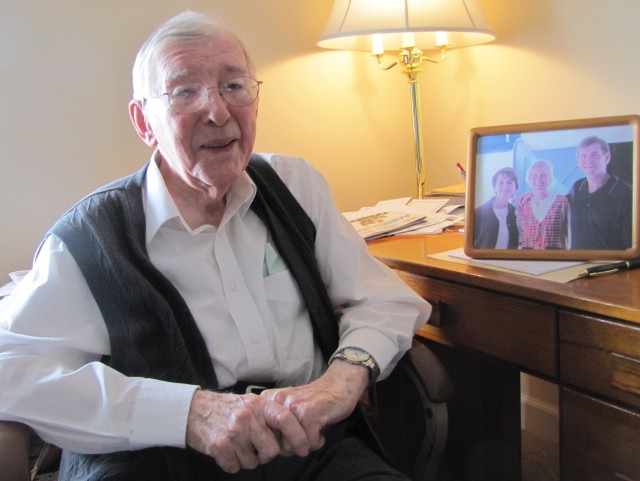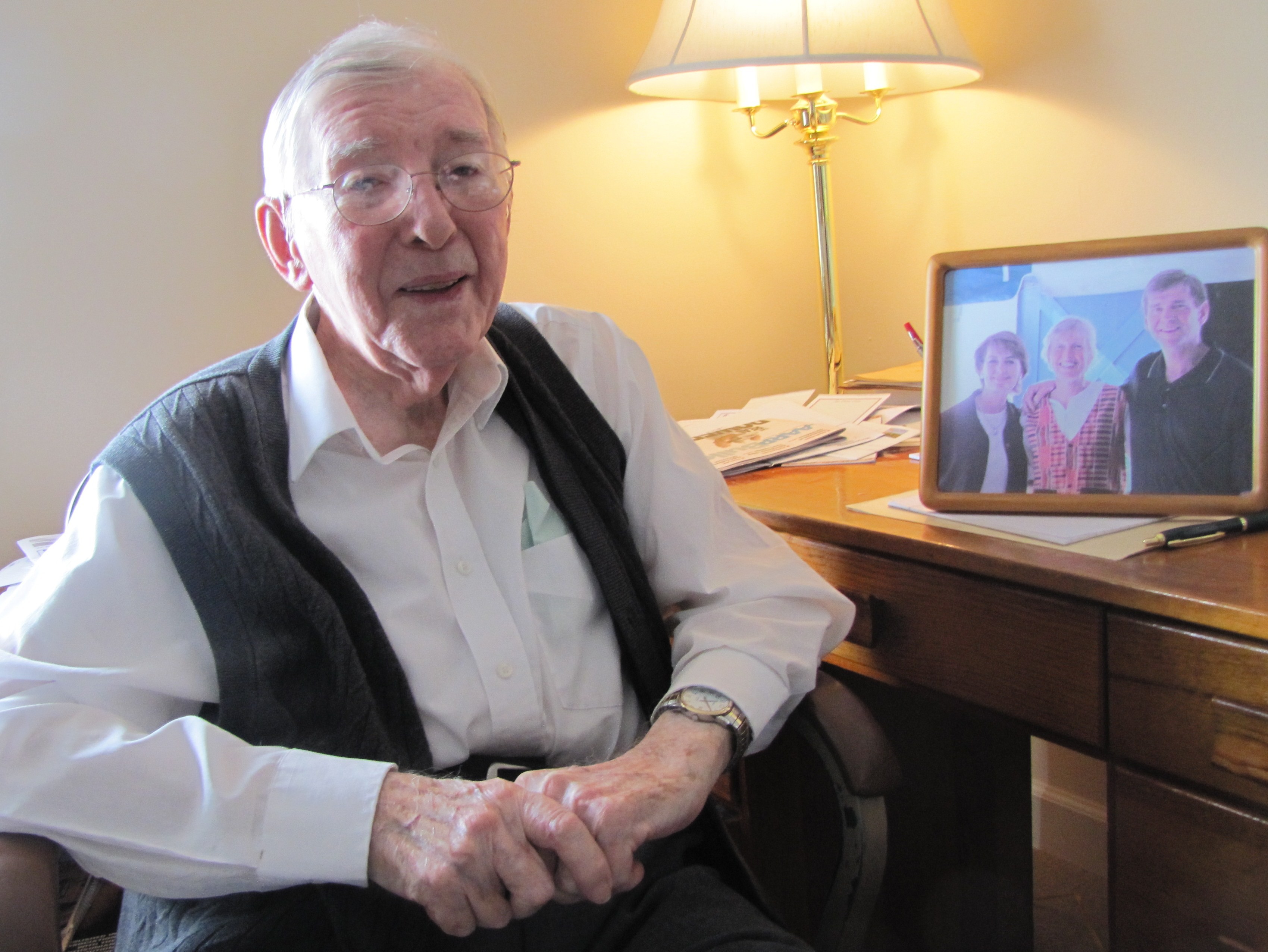
REDSTONE ARSENAL, Ala. -- It can be disheartening to have someone else take control of your dream. So disheartening, in fact, that it can be hard to face the truth.
That's what happened to Dr. Wernher von Braun when the German army took over the research center operations at Peenemunde.
Until 1944, von Braun was convinced his army contract was for the development of a rocket to go into space. That's what he worked for, that's what he told the German scientists on his team.
But the army knew better.
"Peenemunde was not space. But to von Braun, in his mind, it was space," said 97-year-old Dieter Grau, an electrical engineer who was assigned to Peenemunde by the Third Reich.
"Von Braun's real love was space. When he talked, he talked primarily about going into space. Nobody except von Braun talked about space. It was a long way before we came to that. But to go to space we needed the rocket and the army was an opportunity to develop it. The air force developed a flying bomb. Nothing more. It couldn't go into space."
The German air force V-1 - known as the "buzz bomb" or "flying bomb" -- was a cruise missile that used a gasoline powered pulse-jet engine. The V-1 bore no resemblance to the V-2, even though both were under development at Peenemunde at the same time. The V-2 was designed by von Braun's team as a long-range ballistic missile to achieve sub-orbital spaceflight, which it did on Oct. 3, 1942, becoming man's first flight into space.
The V-1 went on to wreak havoc on Europe in the summer of 1944, with a total of 9,251 V-1s launched at Britain, and 2,515 of those actually reaching targets and killing 6,184 civilians and injuring 17,981. Later that same year, the German army began firing the V-2 rocket, with 1,115 V-2s launched to kill an estimated 2,754 civilians and injuring 6,523.
The "vengeance weapons" were only stopped when British and American forces bombed Peenemunde and overran the Third Reich's launch sites. The first strike, by British bombers, came in August 1943, destroying several facilities and causing the Germans to go underground with missile production at Mittelwerk. Von Braun, who said more testing needed to be done before putting the rocket into production, remained with his German scientists at Peenemunde to continue rocket development.
"The German army wanted to build 1,000 V-2s a month. But they never made 1,000 a month. They made some and so many were fired," Grau said. "Production was underground. But when the rockets got to the end of the line, so many of them didn't work.
"I was sent to the plant to find out what's wrong. I was not supposed to talk to the prisoners (who were working production). The people didn't have enough instruction. They didn't understand the design. The people in charge didn't know what to do. And the workers were changed every other week."
________________________________________________________________________
Space Beginnings
Part 5 in series
________________________________________________________________________
Like many of the German scientists, Grau inadvertently became part of the plans for V-2 missile production because of his technical experience and knowledge. An electrical engineer by profession, Grau began working in 1937 for Siemens, the prime contractor for the buildup of Peenemunde, a large, isolated military installation on an island off the northeastern border of Germany. Facilities had to be built to accommodate the research center's growth, which went from 80 researchers in 1936 to nearly 5,000 personnel by late 1942.
"I was on the team that designed and built the power plant and the distribution of power," Grau said.
"Peenemunde was on an island on the Baltic Sea with basically nothing on it but some houses. It was a nice area to spend vacations. Peenemunde was fenced and separated from the public. Our job was to build up the power network and supply. We did not know what Peenemunde does. It was all top secret and we weren't supposed to know anything. We would hear the roar of engines and we got an idea. But I did not know any details."
Before the power plant became operational, Grau was drafted into the German army. During this time, Germany moved against Austria, making it a province of Germany, and then threatened Czechoslovakia and the Soviet Union.
"Siemens tried to get me out of this because Peenemunde was, at this time, ready to get operational and I was needed to help. The request was granted and I was told to report to Peenemunde," Grau said. "There was a lot of pressure to get it operational. It was built up but it had to be set in motion."
Grau was again drafted in 1942, being assigned to a tank company along the Russian border and staying there until July 1943 when Peenemunde once again called.
"Hitler had given high priority to the rocket program," Grau said. "The German army was permitted to take people into the program wherever they could find them. Someone at Peenemunde put my name on the list and said 'this man is an electrical engineer and could probably help us.' The army sent me back home so I could work at Peenemunde.
"But I could not go home. I had to report to Peenemunde. I was surprised I was discharged, but I kept my mouth shut. I had no choice but to go to Peenemunde."
Grau was assigned to test stand seven at Peenemunde.
"That's when I first saw the rocket," he said. "I was somewhat disappointed. It was at the laboratory level. It was not ready for deployment. It needed a lot more work."
Even though it had been fired into sub-orbit and had undergone other firing tests, the rocket was still very much in development. The German scientists were somewhat limited in furthering their rocket research because test firings occurred over the Baltic Sea, with no way of recovering the rocket and its data once fired.
"Another scientist had a new design that would make the rocket better," Grau said. "The former design required 60 relays for each rocket. The new design only required 30 relays. That was tremendous progress ...
"Dr. Wernher von Braun came to see the operation a week later. I told him he had been lied to about difficulties and time delays, that everything wasn't fine. I told him, in my eyes, it's the truth you need to know. You need to know the good things as well as the bad ones, and apparently that impressed him. He talked to me after and asked questions, and I gave him the answers I felt were right."
When the war ended, von Braun and the German scientists feared they would either be killed by their own army or forced to continue their research under the dictatorship of the Soviet Union. They devised a plan of escape and von Braun led a team of 120 German scientists to the Americans. They were assigned to Fort Bliss, Texas, and White Sands, N.M., but they expected to eventually be returned to Germany.
"Americans wanted to have our rockets. They hired us for six months," Grau said. "We thought we would train enough Americans to continue rocket development and then we would go back home. That was extended another six months. But we still thought we'd be returned to Germany and let the Americans do it."
But, it was soon evident that von Braun, and the expertise and knowledge of his German team were vital to developing a space exploration program in the U.S.
"Von Braun was a genius. He had the talent to work with people and inspire them, and he had some qualities to attract topnotch people," Grau said. "If we hadn't of had our years at Peenemunde, and then at Fort Bliss and White Sands, and at Redstone Arsenal, then the American people wouldn't have had a space program. It was a unique time in history."
At White Sands, Grau and other German scientists used the parts of V-2 rockets shipped from Germany to rebuild rockets that could be fired in demonstrations for the U.S. military. Much of the knowledge gained in the development of the V-2 was used at Redstone Arsenal in the development of the Redstone Rocket, the first of America's family of ballistic missiles, the key defender of NATO in Europe during the Cold War and the rocket that was modified to launch America's first satellite - Explorer I - into space.
"The Redstone was a workhorse. It could do all kinds of things," Grau said. "We clustered the rockets together and eventually that cluster design was used for Saturn."
Although the launching of Explorer I in early 1958 was an exciting time of accomplishment for the German scientists and their American counterparts, Grau regrets that it didn't happen sooner.
"I am sorry that it came after Sputnik (the Soviet Union satellite launched into space in October 1957). We weren't allowed to do it sooner," he said, referring to the political climate that limited the German rocket team's work. "We could have done it and been the first ones. Sputnik had to come first to jack up the Americans and really give our space program a push. It was necessary for the future of space exploration."
Like many of the German scientists, he welcomed his family to America while at White Sands. Once they moved to Huntsville and Redstone Arsenal, they knew they had found their new home. Grau's work at the Arsenal supported the design development of the Redstone Rocket. His work later shifted to quality assurance, and he continued to support the nation's space program until his retirement in 1973.
Grau brushes off any queries about his own role in space exploration, saying it was a team effort of German and American scientists.
"This project was so big that, as an individual, I only had one part in it," he said. "I worked 30 years in that arena. We put in 55-hour weeks. It's hard work. It wears you out.
"Not every day was sunshine. We had problems and you had to find solutions and try to find those who can help you. So many sleepless nights are part of it. But it was rewarding how ideas could lead to solutions."
Grau has never had regrets about leaving Germany - or a desire to return, even though his children visited Peenemunde in September with a group from Huntsville.
"I had always thought about leaving Germany someday," Grau said, recalling his younger years. "There were disadvantages there. It's all regulated, and the people live in apartments stacked one on top of each other. Germany is beautiful. But it's not like here where you can have everything if you work for it. Germany is not open, and you have to always watch yourself and what you do."

Social Sharing